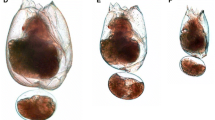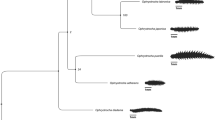Abstract
Gnesiotrochan rotifers display a variety of life styles ranging from taxa with free-swimming larval and sessile adult stages to those with motile adult stages and colonial habits. Several explanations for the C-value enigma posit that genome size is correlated with lifestyle. To investigate this, 13 gnesiotrochan species representing nine genera were measured by flow cytometry. Genome sizes (1C) within Gnesiotrocha ranged from 0.05 pg (Hexarthra mira and Hexarthra fennica) to 0.25 pg (Sinantherina ariprepes). Genome sizes varied within genera and species; e.g., the H. fennica (El Huérfano, Mexico) genome was estimated to be 15% larger than that of H. mira and H. fennica (Keystone Wetland, TX, USA). Gnesiotrochan genome sizes are similar to those reported within Ploima, which range from 0.06 pg (Brachionus rotundiformis, B. dimidiatus) to 0.46 pg (B. asplanchnoidis). Within Gnesiotrocha, genome size was found to be significantly smaller in sessile versus motile species as well as in solitary versus colonial species. To account for phylogenetic background, linear mixed models with hierarchical taxonomic ranks showed that there is a taxonomic component underlying genome size. This study provides the first estimates of genome size within the superorder, providing a baseline for genomic and evolutionary studies within the group.

Similar content being viewed by others
References
Alfsnes, K., H. P. Leinaas & D. O. Hessen, 2017. Genome size in arthropods; different roles of phylogeny, habitat and life history in insects and crustaceans. Ecology and Evolution 7: 5939–5947.
Bennett, M. D., I. J. Leitch, H. J. Price & J. S. Johnston, 2003. Comparisons with Caenorhabditis (approximately 100 Mb) and Drosophila (approximately 175 Mb) using flow cytometry show genome size in Arabidopsis to be approximately 157 Mb and thus approximately 25% larger than the Arabidopsis genome initiative estimate of approximately 125 Mb. Annals of Botany 91: 547–557.
Bevington, D. J., C. White & R. L. Wallace, 1995. Predatory behavior of Cupelopagis vorax (Rotifera; Collothecea; Atrochidae) on protozoan prey. Hydrobiologia 313(314): 213–217.
Bosco, G., P. Campbell, J. T. Leiva-Neto & T. A. Markow, 2007. Analysis of Drosophila species genome size and satellite DNA content reveals significant differences among strains as well as between species. Genetics 177: 1277–1290.
Canapa, A., M. Barucca, M. A. Biscotti, M. Forconi & E. Olmo, 2015. Transposons, genome size, and evolutionary insights in animals. Cytogenetic and genome research 147: 217–239.
Elliott, T. A. & T. R. Gregory, 2015. What’s in a genome? The C-value enigma and the evolution of eukaryotic genome content. Philosophical Transactions of the Royal Society B 370: 20140331.
Epp, R. W. & W. M. Lewis, 1984. Cost and speed of locomotion for rotifers. Oecologia 16: 289–292.
Flot, J. F., B. Hespeels, X. Li, B. Noel, I. Archipova, E. G. J. Danchin, A. Ejnol, B. Henrissat, R. Koszul, et al., 2013. Genomic evidence for ameiotic evolution in the bdelloid rotifer Adineta vaga. Nature 500: 453–457.
Gilbert, J. J., 2018. Attachment behavior in the rotifer Brachionus rubens: induction by Asplanchna and effect on sexual reproduction. Hydrobiologia. https://doi.org/10.1007/s10750-018-3805-7.
Gregory, T. R., 2001a. Coincidence, coevolution, or causation? DNA content, cell size, and the C-value enigma. Biological Reviews of the Cambridge Philosophical Society 76: 65–101.
Gregory, T. R., 2001b. The bigger the C-value, the larger the cell: genome size and red blood cell size in vertebrates. Blood Cells, Molecules and Disease 27: 830–843.
Gregory, T. R., 2005. Genome size evolution in animals. The evolution of the genome. Elsevier, San Diego, CA: 3–87.
Gregory, T. R., 2009. Animal Genome Size Database. [available on internet at http://www.genomesize.com].
Gregory, T. R. & P. D. Hebert, 2003. Genome size variation in lepidopteran insects. Canadian Journal of Zoology 81: 1399–1405.
Hardie, D. C. & P. D. N. Hebert, 2003. The nucleotypic effects of cellular DNA content in cartilaginous and ray-finned fishes. Genome 46: 683–706.
Hughes, A. L. & M. K. Hughes, 1995. Small genomes for better flyers. Nature 377: 391.
Hur, J. H., K. Van Doninck, M. L. Mandigo & M. Meselson, 2009. Degenerate tetraploidy was established before bdelloid rotifer families diverged. Molecular Biology and Evolution 26: 375–383.
Kapusta, A., A. Suh & C. Feschotte, 2017. Dynamics of genome size evolution in birds and mammals. Proceedings of the National Academy of Sciences of the United States of America 114: 1460–1469.
Kidwell, M. G., 2002. Transposable elements and the evolution of genome size in eukaryotes. Genetica 115: 49–63.
Kim, H. S., B. Y. Lee, J. Han, C. B. Jeong, D. S. Hwang, M. C. Lee, H. M. Kang, D. H. Kim, H. J. Kim, S. Papakostas & S. A. Declerck, 2018. The genome of the freshwater monogonont rotifer Brachionus calyciflorus. Molecular ecology resources 18: 646–655.
Kiørboe, T., 2011. How zooplankton feed: mechanisms, traits and trade-offs. Biological Reviews of the Cambridge Philosophical Society 86: 311–339.
Koste, W., 1973. Das Rädertier-Porträt. Ein merkwürdiges festsitzendes Rädertier: Cupelopagis vorax. Mikrokosmos 62: 101–106. In German.
Lynch, M., 2007. The origins of genome architecture. Sinauer Associates Inc, Sunderland.
Lynch, M. & J. S. Conery, 2003. The origins of genome complexity. Science 302: 1401–1404.
Mark Welch, D. M. & M. Meselson, 1998a. Measurements of the genome size of the monogonont rotifer Brachionus plicatilis and the bdelloid rotifers Philodina roseola and Habrotrocha constricta. Hydrobiologia 387(388): 395–402.
Mark Welch, J. L. & M. Meselson, 1998b. Karyotypes of bdelloid rotifers from three families. Hydrobiologia 387: 403–407
Mark Welch, D. B. & M. Meselson, 2001. Rates of nucleotide substitution in sexual and anciently asexual rotifers. Proceedings of the National Academy of Sciences of the United States of America 98: 6720–6724.
Mark Welch, D. B. & M. Meselson, 2003. Oocyte nuclear DNA content and GC proportion in rotifers of the anciently asexual Class Bdelloidea. Biological Journal of the Linnean Society 79: 85–91.
Mark Welch, D. B., J. L. Mark Welch & M. Meselson, 2008. Evidence for degenerate tetraploidy in bdelloid rotifers. Proceedings of the National Academy of Sciences of the United States of America 105: 5145–5149.
May, L., 1989. Epizoic and parasitic rotifers. Hydrobiologia 186/187: 59–67.
Meksuwan, P., P. Pholpunthin & H. Segers, 2013. The Collothecidae (Rotifera, Collothecacea) of Thailand, with the description of a new species and an illustrated key to the Southeast Asian fauna. ZooKeys 315: 1–16.
Meksuwan, P., P. Pholpunthin & H. H. Segers, 2015. Molecular phylogeny confirms Conochilidae as ingroup of Flosculariidae (Rotifera, Gnesiotrocha). Zoologica Scripta 44: 562–573.
Mills, S., J. A. Alcantara-Rodriguez, J. Ciros-Pérez, A. Gómez, A. Hagiwara, K. Hinson Galindo, C. D. Jersabek, R. Malekzadeh-Viayeh, F. Leasi, J.-S. Lee, D. B. Mark Welch, S. Papakostas, S. Riss, H. Segers, M. Serra, R. Shiel, R. Smolak, T. W. Snell, C. P. Stelzer, C. Q. Tang, R. L. Wallace, D. Fontaneto & E. J. Walsh, 2017. Fifteen species in one: deciphering the Brachionus plicatilis species complex (Rotifera, Monogononta) through DNA taxonomy. Hydrobiologia 796: 39–58.
Nishibuchi, G. & J. Déjardin, 2017. The molecular basis of the organization of repetitive DNA-containing constitutive heterochromatin in mammals. Chromosome Research 25: 77–87.
Nowell, R. W., P. Almeida, C. G. Wilson, T. P. Smith, D. Fontaneto, A. Crisp, G. Micklem, A. Tunnacliffe, C. Boschetti & T. G. Barraclough, 2018. Comparative genomics of bdelloid rotifers: insights from desiccating and nondesiccating species. PLoS biology 16: e2004830.
Organ, C. L. & A. M. Shedlock, 2009. Palaeogenomics of pterosaurs and the evolution of small genome size in flying vertebrates. Biology Letters 5: 47–50.
Pagani, M., C. Ricci & C. A. Redi, 1993. Oogenesis in Macrotrachela quadricornifera (Rotifera, Bdelloidea)—I. Germarium eutely, karyotype and DNA content. Hydrobiologia 255: 225–230.
R Core Team, 2018. R: a language and environment for statistical computing. R Core Team. R Foundation for Statistical Computing, Vienna.
Riss, S., W. Arthofer, F. M. Steiner, B. C. Schlick-Steiner, M. Pichler, P. Stadler & C. P. Stelzer, 2017. Do genome size differences within Brachionus asplanchnoidis (Rotifera, Monogononta) cause reproductive barriers among geographic populations? Hydrobiologia 796: 59–75.
Schröder, T. & E. J. Walsh, 2007. Cryptic speciation in the cosmopolitan Epiphanes senta complex (Monogononta, Rotifera) with the description of new species. Hydrobiologia 593: 129–140.
Segers, H., 2007. Annotated checklist of the rotifers (Phylum Rotifera), with notes on nomenclature, taxonomy and distribution. Zootaxa 1564: 1–104.
Segers, H. & R. J. Shiel, 2008. Diversity of cryptic Metazoa in Australian freshwaters: a new genus and two new species of sessile rotifer (Rotifera, Monogononta, Gnesiotrocha, Flosculariidae). Zootaxa 1750: 19–31.
Smith, E. M. & T. R. Gregory, 2009. Patterns of genome size diversity in the ray-finned fishes. Hydrobiologia 625: 1–25.
Stelzer, C. P., 2011. A first assessment of genome size diversity in monogonont rotifers. Hydrobiologia 662: 77–82.
Stelzer, C. P., S. Riss & P. Stadler, 2011. Genome size evolution at the speciation level: the cryptic species complex Brachionus plicatilis (Rotifera). BMC Evolutionary Biology 11: 90–100.
Stemberger, R. S., 1981. A general approach to the culture of planktonic rotifers. Canadian Journal of Fisheries and Aquatic Sciences 38: 721–724.
Tavares, S., A. P. Ramos, A. S. Pires, H. G. Azinheira, P. Caldeirinha, T. Link, R. Abranches, M. D. C. Silva, R. T. Voegele, J. Loureiro & P. Talhinhas, 2014. Genome size analyses of Pucciniales reveal the largest fungal genomes. Frontiers in Plant Science 5: 1–11.
Vadstein, O., L. M. Olsen, & T. Andersen, 2012. Prey-predator dynamics in rotifers: density-dependent consequences of spatial heterogeneity due to surface attachment. Ecology 93: 1795–1801.
Vasisht, H. S. & B. L. Dawar, 1969. Anatomy and histology of the rotifer Cupelopagis vorax Leidy. Research Bulletin (N.S.) Panjab University 20: 207–221.
Vindeløv, L. L., I. J. Christensen & N. I. Nissen, 1983. A detergent-trypsin method for the preparation of nuclei for flow cytometric DNA analysis. Cytometry: The Journal of the International Society for Analytical Cytology 3: 323–327.
Wallace, R. L., 1987. Coloniality in the phylum Rotifera. Hydrobiologia 147: 141–155.
Wallace, R. L., 2002. Rotifers: exquisite metazoans. Integrative and Comparative Biology 42: 660–667.
Wallace, R. L. & P. L. Starkweather, 1985. Clearance rates of sessile rotifers: in vitro determinations. Hydrobiologia 121: 139–144.
Walsh, E. J. & L. Zhang, 1992. Polyploidy in a natural population of the rotifer Euchlanis dilatata. Journal of Evolutionary Biology 5: 345–353.
Wright, N. A., T. R. Gregory & C. C. Witt, 2014. Metabolic “engines” of flight drive genome size reduction in birds. Proceedings of the Royal Society B 281: 20132780.
Young, A. N., R. Hochberg, E. J. Walsh & R. L. Wallace, 2018. Modeling the life history of sessile rotifers: larval substratum selection through reproduction. Hydrobiologia. https://doi.org/10.1007/s10750-018-3802-x.
Zhang, Q. & S. V. Edwards, 2012. The evolution of intron size in amniotes: a role for powered flight? Genome Biology and Evolution 4: 1033–1043.
Acknowledgements
Funding was provided by NSF DEB-1257068 (EJW), National Institute of Health (NIH-NIMHD-RCMI 5G12MD007592), and UTEP’s Dodson research Grant (PDB). Samples were collected under permits TPWD 2016-03, CPDCNBSP-2016-32, and EMNRDSPD 2017. Support from CONABIO “Inventario Multitaxonómico del ANP Médanos de Samalayuca” PJ018, facilitated collections from El Huérfano, Chihuahua, MX (EJW, JRA; SEMARNAT SGPA/DGVS/04784/17). Travis LaDuc facilitated collection at Miller Ranch. Kevin Bixby provided access to La Mancha Wetland. Australian sediment samples were kindly provided by John Gilbert and Russell Shiel. Nic Lannutti, Rick Hochberg, Kevin Floyd, Sergio Samaniego, Enrique Garcia, Judith Ríos-Arana (JRA), and Robert L. Wallace provided plankton and/or vegetation samples. We thank Armando Varela for his help with flow cytometry (BBRC CSI Core Facility, funded by NIH-NIMHD-RCMI 5G12MD007592), Kyung-An Han for providing Drosophila and her students for help with rearing them, and Claus-Peter Stelzer for his advice on flow cytometry methods for rotifers. Robert L. Wallace, the guest editors of the rotifer symposium volume, and two anonymous reviewers made helpful suggestions that greatly improved this manuscript.
Author information
Authors and Affiliations
Corresponding author
Additional information
Guest editors: Steven A. J. Declerck, Diego Fontaneto, Rick Hochberg & Terry W. Snell / Crossing Disciplinary Borders in Rotifer Research
Rights and permissions
About this article
Cite this article
Brown, P.D., Walsh, E.J. Genome size and lifestyle in gnesiotrochan rotifers. Hydrobiologia 844, 105–115 (2019). https://doi.org/10.1007/s10750-018-3873-8
Received:
Revised:
Accepted:
Published:
Issue Date:
DOI: https://doi.org/10.1007/s10750-018-3873-8




